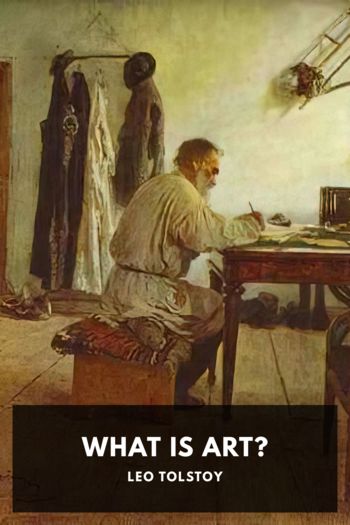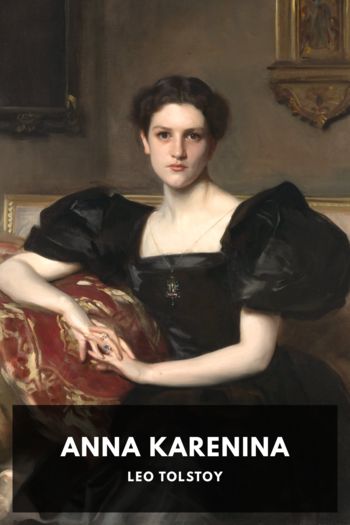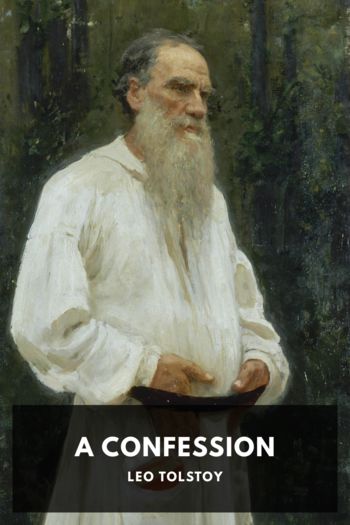What Is Art? by Leo Tolstoy (english readers .txt) 📕

- Author: Leo Tolstoy
Book online «What Is Art? by Leo Tolstoy (english readers .txt) 📕». Author Leo Tolstoy
Well! the reading of the novels and stories by Zola, Bourget, Huysmans, Kipling, and others, handling the most harrowing subjects, did not touch me for one moment, and I was provoked with the authors all the while, as one is provoked with a man who considers you so naive that he does not even conceal the trick by which he intends to take you in. From the first lines you see the intention with which the book is written, and the details all become superfluous, and one feels dull. Above all, one knows that the author had no other feeling all the time than a desire to write a story or a novel, and so one receives no artistic impression. On the other hand, I could not tear myself away from the unknown author’s tale of the children and the chickens, because I was at once infected by the feeling which the author had evidently experienced, re-evoked in himself, and transmitted.
Vasnetsoff is one of our Russian painters. He has painted ecclesiastical pictures in Kiev Cathedral, and everyone praises him as the founder of some new, elevated kind of Christian art. He worked at those pictures for ten years, was paid tens of thousands of roubles for them, and they are all simply bad imitations of imitations of imitations, destitute of any spark of feeling. And this same Vasnetsoff drew a picture for Turgenev’s story “The Quail” (in which it is told how, in his son’s presence, a father killed a quail and felt pity for it), showing the boy asleep with pouting upper lip, and above him, as a dream, the quail. And this picture is a true work of art.
In the English Academy of 1897 two pictures were exhibited together; one of which, by J. C. Dolman, was the temptation of St. Anthony. The Saint is on his knees praying. Behind him stands a naked woman and animals of some kind. It is apparent that the naked woman pleased the artist very much, but that Anthony did not concern him at all; and that, so far from the temptation being terrible to him (the artist) it is highly agreeable. And therefore if there be any art in this picture, it is very nasty and false. Next in the same book of academy pictures comes a picture by Langley, showing a stray beggar boy, who has evidently been called in by a woman who has taken pity on him. The boy, pitifully drawing his bare feet under the bench, is eating; the woman is looking on, probably considering whether he will not want some more; and a girl of about seven, leaning on her arm, is carefully and seriously looking on, not taking her eyes from the hungry boy, and evidently understanding for the first time what poverty is, and what inequality among people is, and asking herself why she has everything provided for her while this boy goes barefoot and hungry? She feels sorry and yet pleased. And she loves both the boy and goodness. … And one feels that the artist loved this girl, and that she too loves. And this picture, by an artist who, I think, is not very widely known, is an admirable and true work of art.
I remember seeing a performance of Hamlet by Rossi. Both the tragedy itself and the performer who took the chief part are considered by our critics to represent the climax of supreme dramatic art. And yet, both from the subject-matter of the drama and from the performance, I experienced all the time that peculiar suffering which is caused by false imitations of works of art. And I lately read of a theatrical performance among the savage tribe the Voguls. A spectator describes the play. A big Vogul and a little one, both dressed in reindeer skins, represent a reindeer-doe and its young. A third Vogul, with a bow, represents a huntsman on snowshoes, and a fourth imitates with his voice a bird that warns the reindeer of their danger. The play is that the huntsman follows the track that the doe with its young one has travelled. The deer run off the scene and again reappear. (Such performances take place in a small tent-house.) The huntsman gains more and more on the pursued. The little deer is tired, and presses against its mother. The doe stops to draw breath. The hunter comes up with them and draws his bow. But just then the bird sounds its note, warning the deer of





Comments (0)